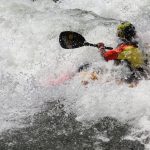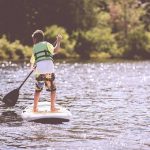The kayaking community often discusses the important role that back muscles play in their activity, far more than arm muscles.
So, let’s start with your back then…
So what muscles does kayaking work?
The three primary muscles in your back that kayaking puts to work, and the drivers behind every kayak paddle stroke, are:
Latissimus Dorsi
The main muscles located in the back area, commonly referred to as lats, are the biggest muscles present. Having a strong core is essential in order to move the power you generate from your legs up into the paddle stroke.
When one arm pulls back and the other pushes out, only to come close to the body; that is your latissimus dorsi muscles working.
Rhomboid Muscles
The rhomboid muscles are responsible for keeping a good kayaking posture as well as for drawing the shoulder blades inwards towards the middle of the spine. This muscular action happens after each stroke and is known as scapular retraction.
Trapezius Muscles
A lot of individuals know the upper trapezius, which is often called the shrug muscles, but the traps also have an effect on the middle and lower areas of the back. These muscles dictate neck and shoulder blade movements.
Kayakers should be mindful not to focus their attention solely on the upper trapezius, making sure to incorporate the middle and lower trapezius into their workouts as well.
Bonus Tip:
Purchasing a kayak seat with a supportive backing can be very beneficial for devoted kayakers.
Particular attention must be paid to posture and method, in combination with a comfortable seat, as a way to maintain one’s back muscles healthy and not experience any pain after paddling.
What Muscles Does Kayaking Work In The Shoulder Area?
The shoulder muscles, the back, and the arm muscles all work together to give a kayaker the best performance they can have.
Kayaking activates the shoulder muscles, particularly the deltoids, and the four rotator cuff muscles work to keep your arms and shoulders steady and moving.
However, the actual load distribution isn’t necessarily equal:
In kayaking, the Posterior deltoids are mainly in charge of the job, which can result in a disproportionate growth in the back of this muscle group. The disproportion of strength in different muscles puts kayakers in danger of damaging their shoulders; from their joint wearing out or even tears in their rotator cuff such as their teres major or teres minor muscles.
You can counter this issue by strengthening your front and back deltoids with exercises that focus on the rotator cuff, such as a high-cable row, a face pull, or power band rotations. Use the following to rephrase the text: Instead, train keeping the “paddler’s box” in mind – an imaginary box formed from your arms, chest, and paddle.
Upper Arms, Forearms & Grip Muscles: Is Kayaking Good For Arms?
Paddling consists of a catch and pull action. When one bicep is contracted, the opposing tricep will react by extending in the opposite direction.
That is basically how competing muscle groups operate.
The strength generated by the back, arms, and core muscles is passed on to the paddle by the biceps, triceps, forearms, and grip while they are working.
Your hands are the most important part of the paddling motion, and your grip strength is what makes it complete. Having the right handle on the paddle is vital for anything else you do.
Your arm muscles are constantly being used when you are controlling and manipulating the paddle. This includes turning, bending, and stretching even when your paddling intensity is not intense.
The first time out kayaking can be a real test of stamina, and usually the arms and upper body can get quite tired. It gets easier with time, though.
Bonus Tip:
Having the right grip is essential, but if you are kayaking in a leisurely manner, loosen your hold. Otherwise, you’re signing up for wrist injuries
Kayaking Works Your Chest Muscles
One arm pushes the paddle in front, while the other arm pulls the paddle back in the opposite direction. Repeat the same motion over and over again, and you will be able to move your kayak through the water.
The pressure that your chest muscles experience from paddling a kayak can be difficult to detect, but it is nonetheless present.
Have you ever done single-arm dumbbell bench presses?
Paddling works the same muscles, but simultaneously and in the opposite fashion:
Your chest region’s top half is mostly made up of your pectoral muscles, which link up the front of your torso to the bones located in your upper arms and across your shoulders.
Your back, arms, and shoulders are all working together; your chest muscles should be taking part as well.
Core: Is Kayaking Good For Abs & Core Strength?
Novices commonly think that a canoeist’s power originates from the arms. Nonetheless, it’s the spin produced by your abdominal muscles, coming from your body turning, that powers the paddling movement.
What’s the connection between your core and kayaking?
Well, much more than you think.
The engagement of core muscles – primarily abdominals and obliques – is crucial, even for the most basic forward kayak stroke:
It all revolves around having a strong core to ensure your rotation, counter-rotation of the upper body, balance, posture, and success in stabilizing you and the kayak.
The majority of the effort involved in kayaking occurs in the upper body, however your abs play a role at all stages of the paddling action.
During your next trip to the gym, set aside some time away from your cardio and other shoulder routines, and do some core exercises. You’ll see a remarkable improvement in your power while out on the water.
The Lower Body Dilemma: What About The Legs & Glutes?
Although it is not as effective as cycling or running, paddling still gives you a workout for your lower body muscles.
“Why do my legs hurt after paddling? Isn’t this supposed to be an upper-body workout?”
Your legs help to keep the rest of your body in balance.
An effective kayak stroke commences with your legs securely seated in the foot braces. As you get better at kayaking, you will find additional ways to employ your legs, for example altering direction, flipping yourself upright, and balancing.
Why are the glutes not given enough credit for their importance to kayaking?
Although widely overlooked, gluteal muscles act as a point of contact between your core and the boat:
The beginning of your stroke comes from your legs, and your body’s center of power and rotations of your torso help to complete it, yet your buttocks and hips bridge the two together. It could be said that the leg muscles play a crucial role in transferring power and initiating torque power.
The “Hip snap” is crucially important in regards to safety as it is vital in rolling the boat back over when performing a safety maneuver.
Is Kayaking Good Cardio Workout?
Below is a compilation of kayak drills that could be included in your routine exercises. If you have yet to begin exercising, it is important to note that you should start by doing simple exercises and gradually increase the difficulty over a period of time. Speak to your doctor prior to commencing a strenuous exercise program.
You should concentrate on these four areas while selecting a workout program to help you reach your kayaking goals:
- Boost the strength of your core muscles. Your core muscles provide you with both steadiness and power throughout a stroke. Abdominal and back exercises can assist you to build these muscles and enhance your skill set.
- Build up your arm and shoulder muscles to aid with endurance. Since both of these muscular groups must be constantly in motion throughout a stroke sequence, kayakers must have strong shoulders and arms.
- Enhanced balance. Increasing the strength of your core muscles can help you balance better. By giving you a sturdy foundation, a strong base will make it easier and more efficient for you to go through your paddling action.
Don’t forget your cardio. For an added boost, use interval training. Swimming is an excellent way to get a full body workout as it engages the most muscles, but cycling and running also supply great benefits.
Kayaking Exercises Benefits
Along with being an excellent way to get moving, kayaking has numerous other health benefits.
Both the physical and emotional health advantages are substantial. Kayaking is ideal for the mental wellbeing of those taking part, as it allows them to enjoy the outdoor environment and exercise while uncovering new spots.
Physical activity, which everyone is aware of, releases endorphins, which are the chemicals responsible for creating positive emotions. Exercising consistently is known to raise spirits and boost overall mental health.
It is easy to meet new people as kayaking is a popular hobby. Finding new acquaintances as an adult might be difficult. It is commonly suggested to take up a new hobby so that one can socialize with others. If you go kayaking on a regular basis, you will probably meet people who share your passions, which could lead to forming relationships and making acquaintances.
In addition, a kayak trip doesn’t have to be just about kayaking. It is possible to combine activities such as biking, walking, or camping with outdoor activities. Embark on the perfect kayak camping trip with your friends.
This guide can help you plan a camping trip that is suitable for kayaking. It covers all the basics as well as places of interest across the United States of America.
Can Kayaking Help You Lose Weight?
Kayaking can be an entertaining way to stay fit, and, when combined with healthy eating, can even lead to weight loss.
You must be aware that losing weight requires that you burn more calories than you consume. You need to take in fewer calories than your body needs on a daily basis. You know that participating in this activity can aid in weight loss as it results in you burning more than 300-400 calories per hour.
Canoeing or kayaking is an excellent way of keeping your muscles, tendons, and joints free from injury. It is essential for individuals who are extremely obese and are looking for an exercise that will not cause harm or lead to accidents.
If your main aim is to shed some pounds, other workout activities might provide more calorie burning. For instance:
- 504 calories per hour for step aerobics
- 648 calories per hour on an elliptical trainer
- Exercise: 432 calories per hour
- Running 10 minutes/mile at 6 mph burns 720 calories per hour.
How Many Calories Are Expended In Kayaking?
Per hour of paddling, kayaking burns 300–420 calories. According to research from Harvard Medical School, the weight of the kayaker affects how many calories are burned:
- An hour of kayaking will burn 300 calories for a 125-pound individual.
- An hour of kayaking will burn 360 calories for a 155-pound individual.
- 185-pound individual kayaking for an hour will use 420 calories.
- As you can see, paddling is an enjoyable approach to burn-resistant fat.
The number of calories burned depends on how much you weigh. A person who weighs 150 pounds can expend more than 350 calories by kayaking for an hour. If you are heavier, you will incinerate more fat since it takes more energy to move your body.
In order to gain the most advantages from paddling, you must put a lot of effort into it. It is not feasible to lose weight by simply drifting down a river.
Good Kayak Technique: It’s Important
It is essential to use correct form while paddling, whether you are going for a relaxed float or competing in rapids with one of the most excellent whitewater kayaks. To conclude, it is important to highlight the importance of employing the right kayaking techniques.
Kayak Guarantees Longevity
Without maintaining equilibrium between our actions and any physical exercise, we are more prone to exhaustion. The positive outcome is that undertaking kayaking on your own can give your body a total exercise.
Nevertheless, if we do not acquire the correct methodology from the outset, we may risk injuring ourselves so severely that it will inhibit us from partaking in kayaking for a prolonged period of time!
It Cuts Down On Fatigue
Your shoulder and arm muscles will tire quickly if you use them only for powering your kayak. Your muscles won’t need to put in as much effort if you perfect your approach to include your entire body.
The main benefit of decreasing fatigue when kayaking is that you can paddle longer distances and explore more remote spots. Long voyages down rivers and overnight kayaking expeditions are only achievable with the proper kayaking skills.
It Stops Injuries
You may prevent overuse injuries by paddling correctly. Kayaking is a perfect activity for achieving balance in your workout routine.
Nevertheless, if you paddle in a wrong way, you are more likely to harm the muscles that are attempting to make up for your wrong technique.




